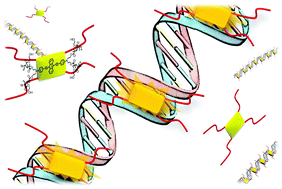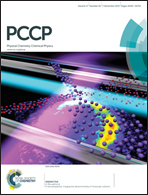Interactions of a biocompatible water-soluble anthracenyl polymer derivative with double-stranded DNA
Abstract
We have studied the interaction of a polymeric water soluble anthracenyl derivative (Ant-PHEA) with salmon testes DNA. The results from UV-Vis, fluorescence, Fourier transform infrared (FT-IR) and circular dichroism spectroscopies indicate that the groove binding process regulates the interaction between Ant-PHEA and DNA. The binding constants, calculated by absorption spectroscopy at 298, 304 and 310 K, were equal to 3.2 × 105 M−1, 4.7 × 105 M−1, and 6.6 × 105 M−1 respectively, proving a relatively high affinity of Ant-PHEA for salmon testes DNA. Results of Hoechst 33258 displacement assays strongly support the groove binding mode of Ant-PHEA to DNA. The association stoichiometry of the Ant-PHEA:DNA adduct was found to be 1 for every 5 base pairs. FT-IR spectra, recorded at different Ant-PHEA/DNA molar ratios, indicate the involvement of the phosphate groups and adenine and thymine DNA bases in the association process. Thermodynamic results suggest that hydrophobic forces regulate the binding of Ant-PHEA with DNA without excluding some extent of involvement of van der Waals forces and hydrogen bonding arising due to surface binding between the hydrophilic polymeric arms of the ligand and the functional groups positioned on the edge of the groove. The resulting composite biomaterial could constitute a valuable candidate for future biological and/or photonic applications.


 Please wait while we load your content...
Please wait while we load your content...